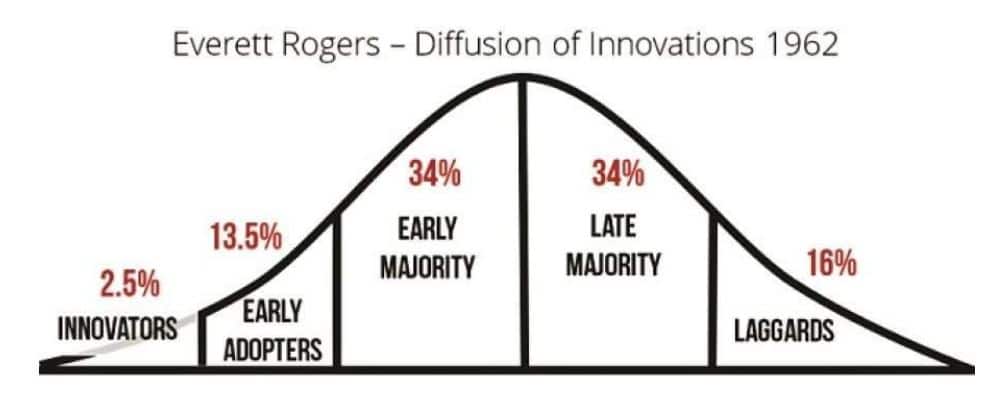by Amyn Amlani, PhD
In 1962, E.M. Rogers developed a theory on how, why, and at what rate new ideas and technology spread. Specifically, this theory, Diffusion of Innovations (DOI), explained how an idea or product gains momentum and diffuses (i.e., spreads) through a specific population or social system.
The principle behind diffusion is that categories of people will progressively embrace new innovation(s) (i.e., idea, behavior, or product), in time, as part of their social system. Adoption is predicated on the person perceiving the idea, behavior, or product as new or advanced.
Adoption Variance
Adoption is a continuous process whereby people increasingly embrace a new innovation over time. This variability in adoption is shown below in Figure 1, and is represented by a bell curve.
Within the bell curve are five categories of adopters, which are discussed below:

Figure 1
- Innovators and Early Adopters are people who want to be the first to try the innovation. People in this category tend to be opinion leaders (i.e., influencers), risk tolerant, and are characterized as having financial liquidity. Collectively, this group makes up the 16% of the population.
- Early Majority adopters embrace innovation only when sufficient evidence highlights the innovation’s effectiveness. People in this category are influenced heavily by feedback from the Innovators and Early Adopters.
- Late Majority are people skeptical to change, and who are willing to adopt an innovation only after it has been tried by the majority. Early Majority and Late Majority adopters make up 68% of the population, and represent the “average” adopter.
- Laggards are adopters last to adopt and are typically averse to change. People in this category are always waiting for “the next best thing.” This group makes up the remaining 16% of the population.
Factors Influencing Adoption
Rogers also identified five factors influencing the adoption of an innovation and, ultimately, its degree of success. He further states that the five attributes explain roughly one-half of the variance in innovations’ rate of adoption.
The five factors are displayed below in Figure 2.

Figure 2
1) Relative Advantage considers whether a new innovation is superior to the alternate solution being replaced. Relative advantage might be conveyed to adopters using strategies such as:
-
- Economic terms (e.g., the new innovation costs more than the older innovation because of its upgrades)
- Convenience factor (e.g., there are fewer connections/steps with the new innovation compared to the old innovation)
- Status aspect (e.g., the innovation has a cool appearance)
Relative advantage alone is not sufficient to increase the cadence to diffusion and adoption.
2) Compatibility measures whether the innovation is consistent with a set of norms, values, and other cultural and social aspects. Failure to embrace the cultural and social sensitivities will yield low diffusion and adoption.
3) Complexity is the level to which an innovation is perceived as being too complex. Complexity is often viewed from the standpoint of user interface or simplicity in achieving the desired outcome. An example of a well-thought-out solution is the Apple iPhone, where hardware and software are easily managed and utilized.
4) Triability is the degree to which an innovation can be experimented by the user on a limited basis. This factor helps decrease barriers to entry for those adopters who are (i) risk averse, (ii) unsure of whether the benefits of the innovation will satisfy their requirements, (iii) seeking assurance that the new innovation is superior to the old innovation, or (iv) a combination of these issues.
5) Innovations that have a lower degree of observability will lend to longer adoption rates, because observable innovations—like the iPhone—advertise for themselves.
What’s Next?
The goal of this blog was to provide the reader with an introduction to the Diffusion of Innovations concept. Subsequent pieces on this topic are currently being developed, with the intent to align this concept in the hearing care space.
In next month’s blog, we will discuss the Diffusion Chasm and how this potential pitfall should be avoided by businesses.






